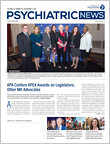As was reported in the August 14 issue of Psychiatric News, a publicly accessible portal on APA’s DSM-5 website was unveiled last December to allow clinicians and researchers to submit proposed updates and changes to DSM-5. Advances in digital publishing have paved the way toward APA’s adopting a continuous improvement model for DSM, in which revisions are pegged to specific scientific advances.
Types of proposed changes include changes to a diagnostic criteria set that would markedly improve its validity or reliability or reduce its deleterious consequences and the addition or deletion of a diagnostic category or specifier. Such proposals must be accompanied by supportive information such as the reasons for the change, data documenting improvements in validity across a range of validators, evidence of reliability and clinical utility, and a consideration of current or potential deleterious consequences associated with the proposed change. Proposals involving corrections and clarifications of existing criteria that do not require empirical support (such as instances of lack of clarity or ambiguity in the meaning of the wording of criteria or text, inconsistencies or contradictions within text or criteria) are also being considered.
Proposals are reviewed by the DSM Steering Committee who, with the assistance of review committees, determine whether the proposal meets its empirical requirements. After approval by the committee, proposed changes are posted for public comment before final approval by the APA Board of Trustees.
Five proposals involving corrections and clarifications that did not require empirical support have recently been approved by the DSM Steering Committee and posted for public comment. The comment period ends December 22.
•
The first proposal concerns a problem with the ICD-10-CM codes assigned to the DSM-5 categories of opioid withdrawal; sedative, hypnotic, or anxiolytic withdrawal; cannabis withdrawal; and stimulant withdrawal. The current diagnostic codes for withdrawal apply only to cases that occur in patients with a diagnosis of a moderate or severe substance use disorder. Given that the development of a withdrawal syndrome can occur only in situations in which the person has stopped or reduced substance use that has been “heavy and prolonged,” it was presumed that substance withdrawal could occur only in cases of moderate to severe substance use disorder (known as substance dependence in DSM-IV), and the appropriate ICD-10-CM diagnostic code for such a scenario was selected.
However, some patients taking prescribed medications daily as directed under medical supervision (that is, opioids, sedative-hypnotic-anxiolytics, cannabis, stimulants) can develop physiological dependence and may develop a withdrawal syndrome when they stop or reduce the medication, thus justifying a diagnosis of substance withdrawal occurring in the absence of a diagnosis of substance use disorder. Consequently, we are proposing that the ICD-10-CM coding notes for these four diagnoses be changed to clarify that a different ICD-10-CM code applies to such situations.
•
The second proposed change is to the definitions of other/unspecified depressive disorder and other/unspecified anxiety disorder. Under DSM-III, patients who present with symptoms that do not meet criteria for one of the specified DSM disorders are to be diagnosed with either an adjustment disorder (if there is an identified causative psychosocial stressor) or the appropriate residual category (atypical depression in DSM-III, depressive disorder NOS in DSM-III-R and DSM-IV, and other/unspecified depressive disorder in DSM-5). To make this happen, the definition of the residual category must include an instruction to diagnose the residual category only if the criteria are not met for one of the specified disorders and not met for adjustment disorder. We are proposing that the exclusion for adjustment disorder, inadvertently omitted from DSM-5, be added.
•
The third proposal provides clarification for how to diagnose cases of symptoms that develop in response to exposure to a traumatic stressor that do not meet criteria for posttraumatic stress disorder (PTSD). According to DSM-5, if the duration of the reaction is six months or less, the appropriate diagnosis is an adjustment disorder since the symptoms do not meet criteria for any specific DSM-5 disorder, and they occur in response to an identified stressor (that is, the traumatic experience). If the symptoms persist for more than six months, however, the diagnosis of adjustment disorder can no longer apply since the duration exceeds that six-month time limit after the termination of the stressor. The appropriate diagnosis for such cases is other trauma- and stressor-related disorder. Consequently, we are proposing to add the following example to its definition: “Persistent response to trauma with PTSD-like symptoms (i.e., symptoms occurring in response to a traumatic event that fall short of the diagnostic threshold for PTSD and that persist for longer than six months).”
•
The fourth proposal corrects an omission in the rating scale for the severity of hallucinations that is part of the clinician-rated dimensions of psychotic symptom severity included in DSM-5 Section III (“Emerging Measures and Models”). Although the anchor points for hallucinations specifically mention only voices (for example, “pressure to act upon voices”), it was intended that hallucinations of all types be included.
•
The fifth proposal concerns a discrepancy in the wording of the stressor criterion (criterion A) in PTSD and acute stress disorder. Criterion A in PTSD requires “exposure to actual or threatened death, serious injury, or sexual violence,” whereas in acute stress disorder, it says, “Exposure to actual or threatened death, serious injury, or sexual violation” (italics added). Since the wording for both of these disorders should be identical, we are proposing that the wording for acute stress disorder be changed to bring it in line with that of PTSD (“sexual violence” replaces “sexual violation”). ■
The proposed changes to
DSM-5 can be accessed
here. Comments may be posted at this site as well.

